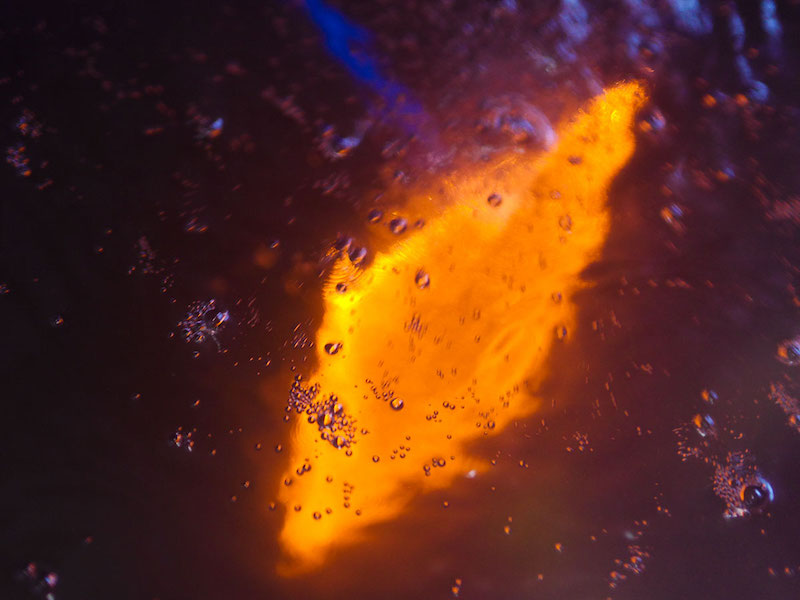Plasma electrolytic oxidation (PEO) is a bath-based method of producing ceramic layers on the surface of light alloys.
 Matt HamblinPEO surface coatings are characterized by their wear resistance, corrosion resistance, and thermal and chemical stability. The method is suitable for alloys of high aluminum, magnesium, and titanium composition but can also be applied to other metals such as zirconium, tantalum, niobium, hafnium, and cobalt.
Matt HamblinPEO surface coatings are characterized by their wear resistance, corrosion resistance, and thermal and chemical stability. The method is suitable for alloys of high aluminum, magnesium, and titanium composition but can also be applied to other metals such as zirconium, tantalum, niobium, hafnium, and cobalt.
Electrolytic oxidation without the use of plasma — anodizing — has been the prevalent technique for many years. The introduction of plasma fundamentally alters coating and performance characteristics in stressful end-use applications.
The use of plasma introduces several benefits:
- Development of harder ceramic phases (including crystallization).
- Chemical passivity - most PEO ceramics are chemically inert.
- Incorporation of elements from the electrolyte into the ceramic to give different properties.
- Reduced stiffness gives high adhesion under mechanical strain or thermal cycling.
- Crack-free edges.
Surface coatings formed through plasma electrolytic oxidation can offer 2x-4x more hardness than hard anodizing or steel and provide increased wear resistance. The combination of these qualities and the comprehensiveness of protection has made PEO a breakthrough surface engineering innovation.
The Plasma Electrolytic Oxidation Process
The process generally follows these stages:
Oxidation of the Substrate
 Figure 1. Plasma discharge around a component immersed in electrolyteAs occurs during anodizing, a component is submerged in a bath of electrolytes. Bath compositions differ based on the desired characteristics of the PEO coating but are usually a proprietary dilute aqueous solution. This is free from chrome and other heavy metals. Additionally, the solution composition is disposable and clean, in contrast to hard anodizing techniques, which employ sulphuric acid (H2SO4).
Figure 1. Plasma discharge around a component immersed in electrolyteAs occurs during anodizing, a component is submerged in a bath of electrolytes. Bath compositions differ based on the desired characteristics of the PEO coating but are usually a proprietary dilute aqueous solution. This is free from chrome and other heavy metals. Additionally, the solution composition is disposable and clean, in contrast to hard anodizing techniques, which employ sulphuric acid (H2SO4).
Depending on the desired coating characteristics, different electrical regimes can be employed. For example, alternating the polarity of an aluminum substrate can achieve variations in growth formation. Higher voltages are typically used to create plasma discharge.
Plasma Modification
In conventional anodizing, the coating growth mechanism causes through-thickness cracks or fissures in the protective layer on corners or uneven surfaces. Additional seals or treatments are necessary to increase the corrosion resistance capabilities of hard anodized components for this reason. These also reduce the fatigue strength of a component, acting as stress raisers.
With PEO, plasma is used to modify the coating during the growth process. This alters the microstructure, resulting in no through-thickness cracks, and provides consequent benefits in corrosion resistance and fatigue strength.
In many cases, the plasma also causes crystallization of the oxide layer, increasing hardness and potential for wear resistance. Micro and nanocrystals such as Al2O2 corundum in aluminum, periclase on magnesium, and anatase/rutile in titanium can be introduced into the ceramic layer for enhanced hardness.
Plasma modification creates other attractive features such as chemical passivity, low stiffness, and thermal stability.
Process Parameters
The processes involved in PEO are highly flexible, particularly when compared to alternatives such as hard anodizing. This opens up a wide range of potential surface coating properties, which can be adapted and tailored to best suit the end-use application of a component:
- PretreatmentPretreatment is simpler for PEO. In many cases, aluminum components may only require a light degrease prior to treatment. By comparison, most anodizing and plating processes will need a cleaner surface, necessitating degreasing, etching, and desmut steps to ensure a high-quality coating.
- Applied electrical parameters can be adjusted based on preferred surface morphology. Coating morphologies can be created with mean length scales from nanometer to micron range.
- Process chemistry can be developed to create different coatings and treat different metals and alloys.
When optimizing a PEO layer for a specific use, the ability to enhance certain coating characteristics is vital to the overall quality and sustainability of a component.
Coating Characteristics
PEO’s unique and flexible process produces highly protective layers that can be enhanced for performance in a specific usage. With the added bonus of being a clean process, free of heavy metals, it’s unsurprising that widespread interest has been sparked in the technique.
Coverage
 Figure 2. Comparative layer structures of hard anodizing coatings (left) and PEO (right).In general, PEO coatings are characterized by good coverage of the component compared to line-of-sight processes such as painting, powder coating, and plasma or flame spray techniques. Also, the insulating properties of the coating ensure good uniformity at corners and edges. Paints tend to thin at corners, whereas electroplating techniques tend to thicken at corners.
Figure 2. Comparative layer structures of hard anodizing coatings (left) and PEO (right).In general, PEO coatings are characterized by good coverage of the component compared to line-of-sight processes such as painting, powder coating, and plasma or flame spray techniques. Also, the insulating properties of the coating ensure good uniformity at corners and edges. Paints tend to thin at corners, whereas electroplating techniques tend to thicken at corners.
As illustrated in the SEM images in Figure 2, PEO layers are characterized by their complex microstructure. The presence of irregularly shaped microcrystals and other features provide more comprehensive protection on corners than through-thickness cracks clearly visible in hard anodized coatings.
Extreme Hardness
 Figure 3. Hardness of PEO layers in pin-on-disc tests.As light alloys become more desirable to work with, both in terms of performance and cost, the need for innovative surface coatings has increased.
Figure 3. Hardness of PEO layers in pin-on-disc tests.As light alloys become more desirable to work with, both in terms of performance and cost, the need for innovative surface coatings has increased.
One such quality is the extreme hardness created in PEO. Typical coatings on aluminum are harder than steel (1600HV vs. 500HV), yet the component itself could be up to 66% lighter. The performance-enhancing characteristics of PEO coatings have enabled light alloys — even magnesium — to prominently feature in aerospace and automotive applications.
This extreme hardness is gained through a combination of crystallization (of the oxides) and co-deposition of elements from the electrolyte in the ceramic layer. Aluminum, for example, can generate a-Al2O3 crystalline phases on AA7075, with hardness up to 2000HV, which outperforms steels on pin-on-disc tests.
Corrosion Resistance
 Figure 4. Polyester powder coat on a PEO coating on a magnesium substrate.For optimal corrosion resistance performance, PEO works best as a pretreatment for subsequent sealers, paints, and other polymers.
Figure 4. Polyester powder coat on a PEO coating on a magnesium substrate.For optimal corrosion resistance performance, PEO works best as a pretreatment for subsequent sealers, paints, and other polymers.
Figure 4 illustrates a polyester powder coat image applied to a PEO layer on a magnesium alloy substrate. The strong bond between the two layers enhances corrosion resistance capabilities, also forming scratch-resistant qualities. The polyester coating effectively fills the pore architecture created during the formation of the PEO layer.
Generally, PEO is good for different types of bonding because its reticulated microstructure creates a physical ‘key’ and does not rely upon chemical compatibility between additional coats, unlike alternative coating mechanisms. The same principle applies to the adhesion of oil and other lubricants in sliding wear applications.
Blanchard et al. (2005), in a study of 25 different surface treatments for magnesium in terms of corrosion, found PEO to surpass the chromium VI and chromium-free alternatives tested. The results are illustrated in Figure 5, with F, G, H, I, and J being derivatives of plasma electrolytic oxidation.
High Strain Tolerance
 Figure 5. Evaluation of Corrosion Protection Methods for Magnesium Alloys in Automotive Applications Blanchard, P.J., Hill, D.J., Bretz, G.T. McCune, R.C., Magnesium Technology, TMS (2005).High hardness alone does not necessarily provide comprehensive wear resistance capabilities. Compliance is also a very valuable property, allowing for some deformation of the component under deflection or thermal expansion without placing undue stress on the coating-metal surface.
Figure 5. Evaluation of Corrosion Protection Methods for Magnesium Alloys in Automotive Applications Blanchard, P.J., Hill, D.J., Bretz, G.T. McCune, R.C., Magnesium Technology, TMS (2005).High hardness alone does not necessarily provide comprehensive wear resistance capabilities. Compliance is also a very valuable property, allowing for some deformation of the component under deflection or thermal expansion without placing undue stress on the coating-metal surface.
Hardness and appropriate levels of compliance combined with increasing the wear resistance of a substrate.
Again, PEO’s unique microstructure gives the material high fracture toughness, reducing the potential for cracking under force, which means ceramic surface coatings provide excellent performance in tribology applications.
Environmental Friendliness
Coating and surface treatments that employ heavy metals (such as nickel, cobalt, and frequently chromium) often involve high-hazard chemicals. Regulations surrounding the use of these are tightening, thus making them more difficult to work with. Conventional anodizing employs strong acids, raising safety issues in use, transportation, and disposal.
PEO is an environmentally safe option. Electrolytic baths are typically low concentration, chemically benign, aqueous solutions. Process waste streams can typically be discharged directly to drain after pH adjustment, so operating licenses are easily obtained. It is for this reason the technique has become popular in highly technical industries that require high-performance surface coats in challenging environments.
Matt Hamblin is CEO of Keronite Group Ltd in the United Kingdom, which is developing, designing, and deploying the world’s most advanced surface treatments for lightweight alloys. Visit www.Keronite.com



































